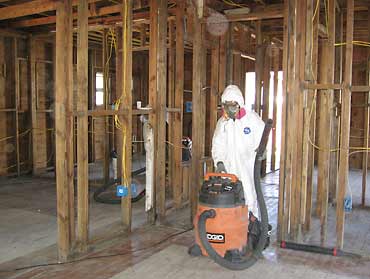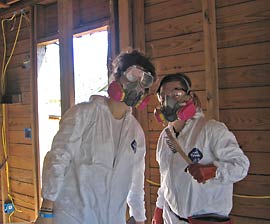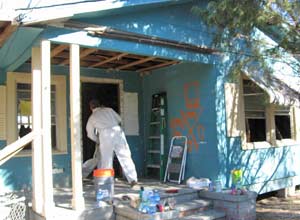UC Berkeley Web Feature
| As part of the mold removal process, a Berkeley student vacuums construction debris in a house gutted by Hurricane Katrina. (Celia Myers photos) |  |
Spring break in Biloxi: Battling mold, months after Katrina
| Dispatch 2:
Hope amid disaster, diversity amid prejudice, and mold amid all Dispatch 3: Building a family while helping other families persevere |
 This is the first in a series of dispatches from Judy Wang (left), a UC Berkeley third-year double major in molecular and cell biology and psychology. She's on spring break in Mississippi, helping with Hurricane Katrina relief efforts as part of the campus's Alternative Breaks program, which was created by students five years ago at the Cal Corps Public Service Center. She wrote this dispatch on Sunday, March 26, the second day of her trip to Biloxi. On other service-learning experiences offered this week through Alternative Breaks, UC Berkeley students are studying immigration and border issues in the San Diego-Tijuana area and doing two projects in Oakland and San Francisco - one on nonviolence, the other about environmental sustainability and food justice.
This is the first in a series of dispatches from Judy Wang (left), a UC Berkeley third-year double major in molecular and cell biology and psychology. She's on spring break in Mississippi, helping with Hurricane Katrina relief efforts as part of the campus's Alternative Breaks program, which was created by students five years ago at the Cal Corps Public Service Center. She wrote this dispatch on Sunday, March 26, the second day of her trip to Biloxi. On other service-learning experiences offered this week through Alternative Breaks, UC Berkeley students are studying immigration and border issues in the San Diego-Tijuana area and doing two projects in Oakland and San Francisco - one on nonviolence, the other about environmental sustainability and food justice.
By Judy Wang | Sunday, March 26, 2006
BILOXI, Miss. —After spending an entire day traveling across the country from Oakland to Atlanta and landing in New Orleans around 9 p.m., we arrived late on Saturday morning in Biloxi, Miss. It wasn't without the usual unexpected occurrences — a flat tire being one of them. Our home for the week is the Hands On Network's civic center. It is behind a Methodist church kind enough to rent out its newly built recreational center for Hands On and its volunteer efforts.
 A pair of Berkeley students take a break from their mold cleanup chores. |
We were awakened around 8 a.m. this morning and, after a hearty breakfast, one of the coordinators gave us a tour of the facilities. After splitting into two groups, we began our tasks for the day — "mold" and "interior."
One group was sent off to tackle the mold problem that has infiltrated the Gulf Coast since Hurricane Katrina. Mold has become an enormously difficult problem here due to the flood waters reaching such a high level and flooding numerous houses. Five other Cal students and I were driven to a local neighborhood and went to a house that had already been mostly gutted — only the wooden foundations of the walls and ceilings, and the tiles of the floor, were remaining.
We had to remove all of the sheet metal, the plywood and some of the unnecessary wall foundations so later teams could come by the house to get rid of the mold in the house and seal the structure to prevent it from regrowing. We used crowbars and hammers to "take out our aggression and anger," as our team leader suggested. As part of the "interior" team, we took out an entire wall of cabinets, a built-in entertainment center, and an air-conditioning unit.
 A highway causeway at "the Point" in Biloxi, shattered by the fury of Hurricane Katrina. |
Katrina's flood waters had left grass up above our heads on the exterior walls of the house. Video tapes and an ATM card were found in the walls, presumably belonging to the house's owner. It was so haunting to realize that people with real lives had inhabited this home, and it was hard to imagine what Biloxi had been like prior to Hurricane Katrina. We ate lunch at "the Point", where a major highway had been shattered into parts. It reminded many of us who remember the 1989 Loma Prieta and 1994 Northridge earthquakes of what our bridges and roads looked like after major earthquakes.
About halfway through the day, one of the neighbors across the street from the house we were working on stopped by, and it was the first time I had heard from someone who had been through Hurricane Katrina. After a glass sliding door literally exploded from the pressure of the rising flood waters, he was left with nine teeth less than he had started with and continued to wait out the storm with his surfboard for hours, in case the flood waters rose past his second story window. He is the only person still living on his block, was lucky enough to have flood insurance, and was apprehensive about what the future would bring. In his own words, "God took a break, and the devil came by." He thanked us and the many volunteers, and I have a feeling that gratitude will be expressed throughout the week from strangers we have yet to encounter.
We finished with our work around 4 p.m., and our team leader drove us around Biloxi so we could have a look at Katrina's devastation. On this car ride, it finally hit home: Honey, we're not in California anymore. A grim scene awaited us — many houses practically destroyed, with FEMA trailers in the driveways. Trees were bent over sideways and, in some places, only signs remained.
 In a house rendered uninhabitable by floodwaters from Hurricane Katrina, the orange legend spray-painted on a porch wall tells the tale: inspected 9/1/05, salvageable, no bodies found inside. |
There were spray-painted messages on several houses: "FEMA, GO TO" with the latter word painted out, "DO NOT BULLDOZE. STILL ALIVE AND KICKING," and what may have been the most ominous — Xs, with numbers and digits surrounding the X on each house. We learned that one of the numbers was the date the house was inspected; a number from 1-5 told the extent of the damage of the house; and one number indicated the number of dead bodies found inside. Entire neighborhoods were wiped out. Although I had seen on TV the scenes from New Orleans and Biloxi after Hurricane Katrina left the Gulf, they did not come close to the devastation I was seeing in person.
It is painfully obvious that it will take years and years for Biloxi, and the rest of the Gulf Coast, to redevelop and rebuild. People are slowly beginning to come back to Biloxi, but for the most part, especially in West Biloxi where Katrina hit the hardest, it is reminiscent of a ghost town.
Tomorrow, our team from Cal splits into four teams. One will be going to the local elementary school to tutor students and serve as student aides; two will continue mold and interior work, and yet another will be surveying the local community about what issues should be addressed and to promote a town meeting for the residents of Biloxi. The coming week should provide more learning and life-changing experiences for our diverse group of 22.

